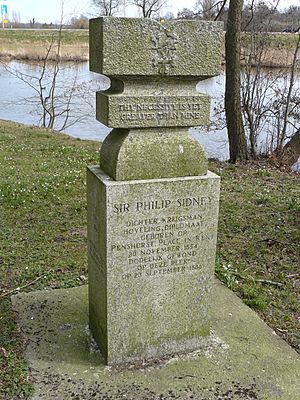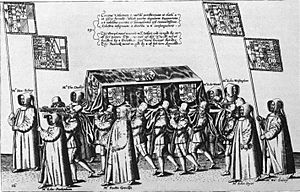Philip Sidney facts for kids
Quick facts for kids
Sir Philip Sidney
|
|
|---|---|

Sir Philip Sidney, after Antonis Mor
|
|
| Born | 30 November 1554 Penshurst Place, Kent, England |
| Died | 17 October 1586 (aged 31) Zutphen, Netherlands |
| Buried | Old St Paul's Cathedral, London |
| Noble family | Sidney |
| Spouse(s) | Frances Burke, Countess of Clanricarde |
| Father | Sir Henry Sidney |
| Mother | Lady Mary Dudley |
Sir Philip Sidney (born November 30, 1554 – died October 17, 1586) was an important English writer, soldier, and courtier (a person who attended a royal court). He is known as one of the most famous people of the Elizabethan era, which was the time when Queen Elizabeth I ruled England.
Sidney wrote many famous works. These include a collection of love poems called Astrophel and Stella. He also wrote a book about poetry called The Defence of Poesy. Another well-known work is his adventure story, The Countess of Pembroke's Arcadia.
Contents
Early Life and Family
Philip Sidney was born into a noble family at Penshurst Place in Kent. He went to Shrewsbury School and then to Christ Church, Oxford University.
His father was Sir Henry Sidney. His mother was Lady Mary Dudley. Her family was very powerful. She was the sister of Robert Dudley, 1st Earl of Leicester, a close friend of Queen Elizabeth I.
Philip had a younger brother named Robert. Robert became a statesman and supported artists. Philip also had a younger sister, Mary. She was a writer and translator. Philip dedicated his longest work, the Arcadia, to her. After Philip died, Mary helped to rework and publish the Arcadia. It then became known as The Countess of Pembroke's Arcadia.
Politics and Travel
In 1572, when he was 18, Philip Sidney became a Member of Parliament for Shrewsbury. That same year, he traveled to France. He was part of a group trying to arrange a marriage between Queen Elizabeth I and a French prince.
He spent the next few years traveling across Europe. He visited Germany, Italy, Poland, Hungary, and Austria. During these trips, he met many important thinkers and politicians.
When he returned to England in 1575, Sidney met Penelope Devereux. She was much younger than him. Later, she would inspire his famous love poems, Astrophel and Stella.
Sidney was also involved in politics in England. He defended his father's work in Ireland. He also disagreed with some of Queen Elizabeth's plans, like her possible marriage to the French prince. This led to some arguments at court.

By 1581, Sidney was back at court. In 1584, he was a Member of Parliament for Kent. He was made a knight in 1583.
In 1583, he married Frances, who was 16 years old. She was the daughter of Sir Francis Walsingham, a very important advisor to Queen Elizabeth. In the same year, Sidney visited Oxford University with Giordano Bruno. Bruno was a famous thinker known for his ideas about the universe.
In 1585, Philip and Frances had one daughter, Elizabeth. She later married Roger Manners, 5th Earl of Rutland.
His Writings
Philip Sidney was a talented writer in many different styles. However, none of his major works were published while he was alive.
His most famous writing is a collection of 108 love poems called Astrophel and Stella. These poems were inspired by Penelope Devereux. They show Sidney as one of the best English poets of his time, after Shakespeare.
While he was away from court, he wrote Astrophel and Stella, the first version of The Arcadia, and The Defence of Poesy.
His adventure story, The Arcadia (published in 1598), is a complex love story. It shows the ideals of medieval chivalry (the code of knights). The story has many different parts and characters. The way he wrote it was very poetic and descriptive.
Sidney also met other famous writers like Edmund Spenser. Spenser dedicated his book The Shepheardes Calender to Sidney. Sidney was part of a group of poets who wanted to make English poetry more like classical Greek and Roman poetry.
Military Service
Sidney was also an active soldier. He was a strong Protestant and believed in fighting against the Catholic Church and Spain. He was in Paris during the terrible Saint Bartholomew's Day Massacre, which made him even more committed to the Protestant cause.
In the 1570s, he tried to get Protestant countries to work together against Spain. In 1583, he was promoted to General of Horse. In 1585, he became governor of Flushing in the Netherlands. This allowed him to actively fight for the Protestant side. He led a successful attack on Spanish forces near Axel in July 1586.
Injury and Death
Later in 1586, Sidney joined Sir John Norris in the Battle of Zutphen in the Netherlands. They were fighting against the Spanish. During the battle, Sidney was shot in the thigh. He died 26 days later from gangrene (a serious infection), at the age of 31.
There is a famous story about his death. It says that Sidney took off his thigh armor because one of his men was not fully armored. He believed it was wrong to be better protected than his soldiers. As he lay dying, he was very brave. The most famous part of the story is when he gave his water to another wounded soldier, saying, "Thy necessity is yet greater than mine." This story shows his noble and generous character.
Sidney's body was brought back to London. He was buried in Old St Paul's Cathedral on February 16, 1587. His grave was destroyed in the Great Fire of London in 1666. Today, a modern monument in the cathedral lists his name among important people whose graves were lost.
Even during his lifetime, but especially after his death, Philip Sidney was seen as the perfect example of a courtier. He was known for being smart, polite, brave, and generous. His funeral was one of the most detailed and expensive ever held.
Although he was not a major political leader, he was remembered as a great English hero. His friend, Fulke Greville, wrote an early biography about him. While many people thought Sidney was a very strict Protestant, some historians now believe his religious views might have been more open. He was known to be friendly with some Catholics.
See also
 In Spanish: Philip Sidney para niños
In Spanish: Philip Sidney para niños



